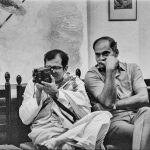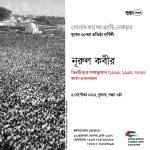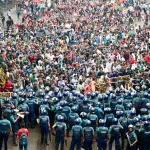Shahidul Alam, on why he thinks India?s photography movement hasn?t taken off yet
BY Ronny Sen EMAIL AUTHOR(S)
![?I had such a big influence on the community at large that there was a tendency [towards] cloning, the classical black-and-white documentary approach to photography, beautifully composed perhaps, but in a predictable way, in a I-have- seen-it-before way? (Photo: RONNY SEN) ?I had such a big influence on the community at large that there was a tendency [towards] cloning, the classical black-and-white documentary approach to photography, beautifully composed perhaps, but in a predictable way, in a I-have- seen-it-before way? (Photo: RONNY SEN)](http://www.openthemagazine.com/sites/default/files/imagecache/435by290/article_images/10768.alamp.jpg)
?I had such a big influence on the community at large that there was a tendency [towards] cloning, the classical black-and-white documentary approach to photography, beautifully composed perhaps, but in a predictable way, in a I-have- seen-it-before way? (Photo: RONNY SEN)
In the world of photography, Shahidul Alam needs no introduction. He started as a photographer of children, and went on to make a substantial contribution to the medium and its practice not just in his country, Bangladesh, but in the Subcontinent. He set up a photography school, Pathshala, in conjunction with the World Press Photo educational initiative. And he was instrumental in starting Asia?s very first photo festival, Chobi Mela, which attracts the world?s top professionals. In this conversation, he tells Open why the Indian photography movement lags others?, and how Bangladeshi photographers have finally quit cloning his work.
Q You have been instrumental in the development of documentary photography in the Subcontinent over the past couple of decades. How do you feel about the changes that have taken place?
A I am happy that some changes have taken place. I am conscious that there is a mountain ahead that needs to be climbed. But I had no illusions that it was going to be easy. The fact that we have been able to get here is important. The fact that there are now so many talented photographers from this region who have made their mark in the field of photography and that the world looks at this part of the world for inspiration in photography is phenomenal. But I think it?s also true that even now, the gatekeepers are in the West. And until that changes, the dynamics of the industry will not change, the politics of the way the pictures are used will not change, and the reason we started on this journey will not have been achieved.
Q You have frequently served as a jury member for the World Press Photo awards and have even presided over the jury. You have been influential in shaping the contemporary discourse on photography. What is the West?s perception of you?
A I don?t think it?s fair to consider [the West?s opinion] as homogeneous. There is a whole range of people out there, with different politics, with different mindsets and there are a whole range of people here with different politics and different mindsets. Certainly there are a lot of people who want to protect the way they are. There are others who recognise that in this profession, in this medium, there is a whole lot of talent that needs to be nurtured. While all my professional life I have challenged Western hegemony, I have questioned the dominance of the Western media, I have also very actively worked with many, many people in the West, top professionals who have worked for the betterment of photography in this region. My school is one example. When we started teaching photography, we had zero resources. We didn?t actually have a bed in our flat, so I remember buying a second-hand cane bed because these famous foreign photographers were going to come and we couldn?t have them sleeping on the floor. So they slept on this bed?they were usually too tall to fit in, but that?s where they slept. They gave quality time to my students; they have in so many ways become a part of this movement. So I don?t treat them as one homogeneous unit. I think there is a big part of the industry that is only interested in its survival. There is another group of very passionate, dedicated photojournalists, photographers of many types who generally want their stories to be told.
Q Bangladeshi photography is well received at an international level. Pathshala, your brainchild, has been at the forefront of this movement. Pathshala, Chobi Mela and the discipline and rigour that your students are infused with find resonance in the international photographic community. India is yet to witness such a phenomenon. Do you think it is because there is no one quite as visionary as you in India?
A India is a huge country with enormous resources and some very fine photographers. What it lacks is a photographic movement. I think if you look at what we started doing?it was 1984 when we started, the photo agency was set up in 1989, the school was set up in 1998, the festival started in 2000?they were all building blocks, one leading to the other, and it was all part of a well thought-out structured campaign as opposed to small ad-hoc things. I think what has happened in India are isolated events that individuals have done which have worked or not worked at various stages, but there?s never been a collective movement in a particular direction with a clear strategy. I think that is where the difference between these two countries lies.
Q How do you think the younger generation of Bangladeshi photographers are moving ahead in terms of their visual language?
A It?s a very exciting shift actually, because one of the things I was concerned about was my own influence. In a sense, I had such a big influence on the community at large that there was a tendency [towards] cloning, the classical black-and-white documentary approach to photography, beautifully composed perhaps, but in a predictable way, in a I-have-seen-it-before way. Despite the fact that all the tutors that we have brought to Bangladesh were pulling in different directions and providing very different examples, still a presence is a presence and one cannot ignore it. And success does also create a tendency to replicate, so sometimes people who are successful replicate themselves. That did happen to an extent in Bangladesh. But now I actually see a very vibrant approach, where photographers are actively seeking out their own space, their own visual grammar; they are finding their own vocabulary and looking at photography in a very, very different way. And I am very encouraged by it. What I am disappointed by is the fact that while we have great photographers, we don?t have the other professions surrounding photography. We do not have writers on photography at all, we don?t have good curators, we don?t have picture researchers, we don?t have good photo editors, we don?t have good agencies, agents for photographers. These all have to be in place for the medium and for the professional industry to be robust, sustainable and creatively vibrant.
Q And young photographers in India?
A There is a very vibrant kind of work being practised in India. But one has to find it, and one has to look for it. It is not so easily apparent. What I am a bit concerned about is that some of the work appears to me as posturing. Some of the work is catering to what a market at a particular time wants. I think the personal work that one would hope for, the level of maturity one expects of the photographer isn?t sufficiently visible. Maybe I am not seeing it, I don?t know, but at the moment I am curating a major show for Musse du quai Branly in Paris, for which I am looking at Indian photography, obviously Bangladeshi photography, photography all across SAARC, including Myanmar, and it seems that beyond a point it?s the visual posturing that presents itself and not as much substance as I would like to see.
Q How do you think the photography scene will evolve in the subcontinent?
A What I am concerned about is the dilution of what we are trying to do. I have for a long time tried to create a situation where Bangladeshi photographers can tell their own stories. But the reality is that the client is still out there, so I know for a fact that a lot of our photographers will be delivering work which the West will want to buy, or the West will appreciate, or the West will value. It?s a phase we need to go through, but I hope we go beyond that to develop something which is very much a reflection of our own values, a sense of our concerns, and caters to the needs of our own community.
Q What advice would you give to the younger generation of photographers in India?
A I think first recognise that one is a human being before one is a photographer because that has to be the guiding force. The other one is to keep one?s demands to the minimum. By demands, I am talking of material demands, not aspirations. I think aspirations should be sky high or further. But material demands being less frees people enormously. I think there are too many photographers who give up that freedom too easily. We go through life and we go through the mechanics of consumerism, of having property and acquisitions of many forms. And that becomes so all-consuming that we forget why we are here in the first place. If all one has done is acquired property and acquired wealth, then one has not lived. And I want to live.
Q You have been instrumental in the development of documentary photography in the Subcontinent over the past couple of decades. How do you feel about the changes that have taken place?
A I am happy that some changes have taken place. I am conscious that there is a mountain ahead that needs to be climbed. But I had no illusions that it was going to be easy. The fact that we have been able to get here is important. The fact that there are now so many talented photographers from this region who have made their mark in the field of photography and that the world looks at this part of the world for inspiration in photography is phenomenal. But I think it?s also true that even now, the gatekeepers are in the West. And until that changes, the dynamics of the industry will not change, the politics of the way the pictures are used will not change, and the reason we started on this journey will not have been achieved.
Q You have frequently served as a jury member for the World Press Photo awards and have even presided over the jury. You have been influential in shaping the contemporary discourse on photography. What is the West?s perception of you?
A I don?t think it?s fair to consider [the West?s opinion] as homogeneous. There is a whole range of people out there, with different politics, with different mindsets and there are a whole range of people here with different politics and different mindsets. Certainly there are a lot of people who want to protect the way they are. There are others who recognise that in this profession, in this medium, there is a whole lot of talent that needs to be nurtured. While all my professional life I have challenged Western hegemony, I have questioned the dominance of the Western media, I have also very actively worked with many, many people in the West, top professionals who have worked for the betterment of photography in this region. My school is one example. When we started teaching photography, we had zero resources. We didn?t actually have a bed in our flat, so I remember buying a second-hand cane bed because these famous foreign photographers were going to come and we couldn?t have them sleeping on the floor. So they slept on this bed?they were usually too tall to fit in, but that?s where they slept. They gave quality time to my students; they have in so many ways become a part of this movement. So I don?t treat them as one homogeneous unit. I think there is a big part of the industry that is only interested in its survival. There is another group of very passionate, dedicated photojournalists, photographers of many types who generally want their stories to be told.
Q Bangladeshi photography is well received at an international level. Pathshala, your brainchild, has been at the forefront of this movement. Pathshala, Chobi Mela and the discipline and rigour that your students are infused with find resonance in the international photographic community. India is yet to witness such a phenomenon. Do you think it is because there is no one quite as visionary as you in India?
A India is a huge country with enormous resources and some very fine photographers. What it lacks is a photographic movement. I think if you look at what we started doing?it was 1984 when we started, the photo agency was set up in 1989, the school was set up in 1998, the festival started in 2000?they were all building blocks, one leading to the other, and it was all part of a well thought-out structured campaign as opposed to small ad-hoc things. I think what has happened in India are isolated events that individuals have done which have worked or not worked at various stages, but there?s never been a collective movement in a particular direction with a clear strategy. I think that is where the difference between these two countries lies.
Q How do you think the younger generation of Bangladeshi photographers are moving ahead in terms of their visual language?
A It?s a very exciting shift actually, because one of the things I was concerned about was my own influence. In a sense, I had such a big influence on the community at large that there was a tendency [towards] cloning, the classical black-and-white documentary approach to photography, beautifully composed perhaps, but in a predictable way, in a I-have-seen-it-before way. Despite the fact that all the tutors that we have brought to Bangladesh were pulling in different directions and providing very different examples, still a presence is a presence and one cannot ignore it. And success does also create a tendency to replicate, so sometimes people who are successful replicate themselves. That did happen to an extent in Bangladesh. But now I actually see a very vibrant approach, where photographers are actively seeking out their own space, their own visual grammar; they are finding their own vocabulary and looking at photography in a very, very different way. And I am very encouraged by it. What I am disappointed by is the fact that while we have great photographers, we don?t have the other professions surrounding photography. We do not have writers on photography at all, we don?t have good curators, we don?t have picture researchers, we don?t have good photo editors, we don?t have good agencies, agents for photographers. These all have to be in place for the medium and for the professional industry to be robust, sustainable and creatively vibrant.
Q And young photographers in India?
A There is a very vibrant kind of work being practised in India. But one has to find it, and one has to look for it. It is not so easily apparent. What I am a bit concerned about is that some of the work appears to me as posturing. Some of the work is catering to what a market at a particular time wants. I think the personal work that one would hope for, the level of maturity one expects of the photographer isn?t sufficiently visible. Maybe I am not seeing it, I don?t know, but at the moment I am curating a major show for Musse du quai Branly in Paris, for which I am looking at Indian photography, obviously Bangladeshi photography, photography all across SAARC, including Myanmar, and it seems that beyond a point it?s the visual posturing that presents itself and not as much substance as I would like to see.
Q How do you think the photography scene will evolve in the subcontinent?
A What I am concerned about is the dilution of what we are trying to do. I have for a long time tried to create a situation where Bangladeshi photographers can tell their own stories. But the reality is that the client is still out there, so I know for a fact that a lot of our photographers will be delivering work which the West will want to buy, or the West will appreciate, or the West will value. It?s a phase we need to go through, but I hope we go beyond that to develop something which is very much a reflection of our own values, a sense of our concerns, and caters to the needs of our own community.
Q What advice would you give to the younger generation of photographers in India?
A I think first recognise that one is a human being before one is a photographer because that has to be the guiding force. The other one is to keep one?s demands to the minimum. By demands, I am talking of material demands, not aspirations. I think aspirations should be sky high or further. But material demands being less frees people enormously. I think there are too many photographers who give up that freedom too easily. We go through life and we go through the mechanics of consumerism, of having property and acquisitions of many forms. And that becomes so all-consuming that we forget why we are here in the first place. If all one has done is acquired property and acquired wealth, then one has not lived. And I want to live.






Leave a Reply
You must be logged in to post a comment.